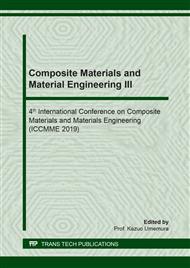p.89
p.95
p.101
p.109
p.115
p.121
p.127
p.133
p.139
Mechanical Properties of Capsaicum Oleoresin (CO) Impregnated in Porous Silica/Polylactic Acid (PLA) Composites
Abstract:
Flexibility of Polylactic acid (PLA) is improved by mixing capsicum oleoresin (CO) impregnated in mesoporous silica (SiCO) in the PLA matrix with SiCO concentration of 0.77 wt%, 1.54 wt% and 3.08 wt%. CO extracted from hot chili (Capsicum frutescens linn) is natural oil, non-toxic and good for environment. The SiCO/PLA composites were investigated water absorption, tear resistance and hardness properties. The improvement of tear strength of SiCO/PLA composites is due to increase in chain mobility of PLA because of the presence of capsicum oil. Hardness of the PLA composites slightly reduces with increasing SiCO concentration. SiCO/PLA composites are suitable for food packaging due to slightly water absorption. SiCO can improve flexibility of PLA. The optimum content of SiCO in PLA matrix is 3.08 wt%.
Info:
Periodical:
Pages:
115-120
Citation:
Online since:
May 2019
Authors:
Price:
Сopyright:
© 2019 Trans Tech Publications Ltd. All Rights Reserved
Share:
Citation:


